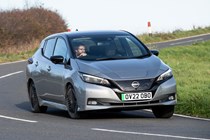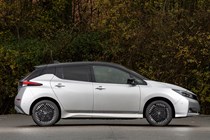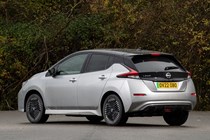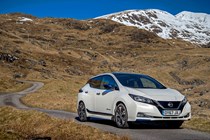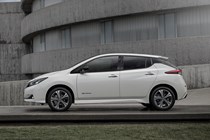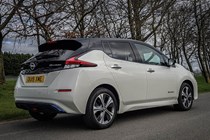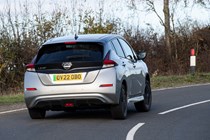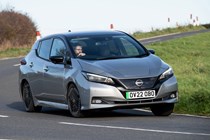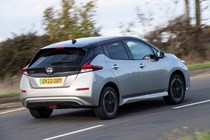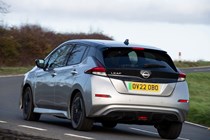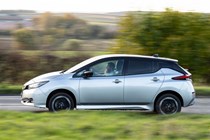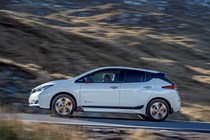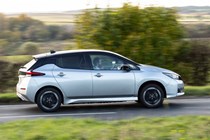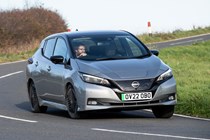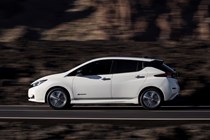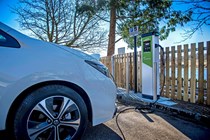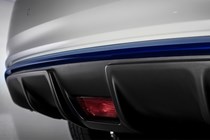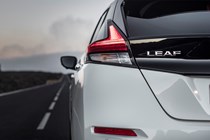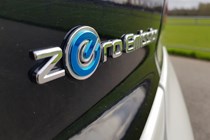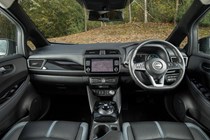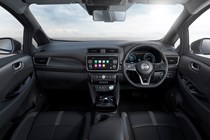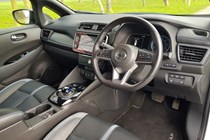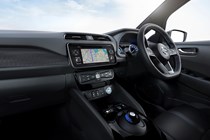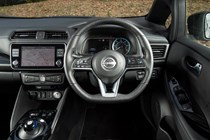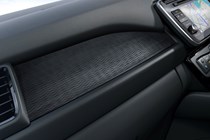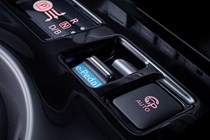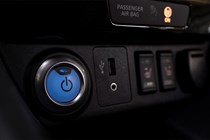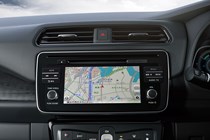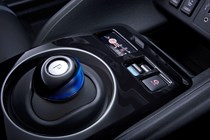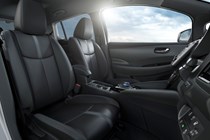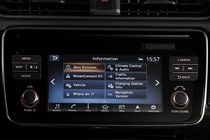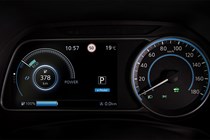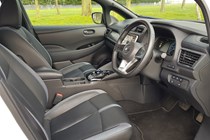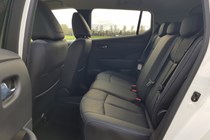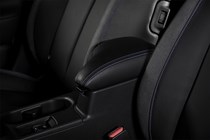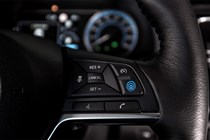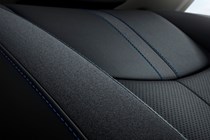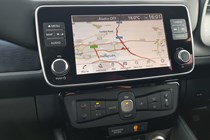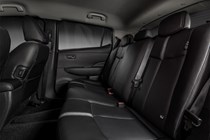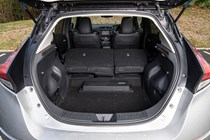
Nissan Leaf boot space, practicality and safety
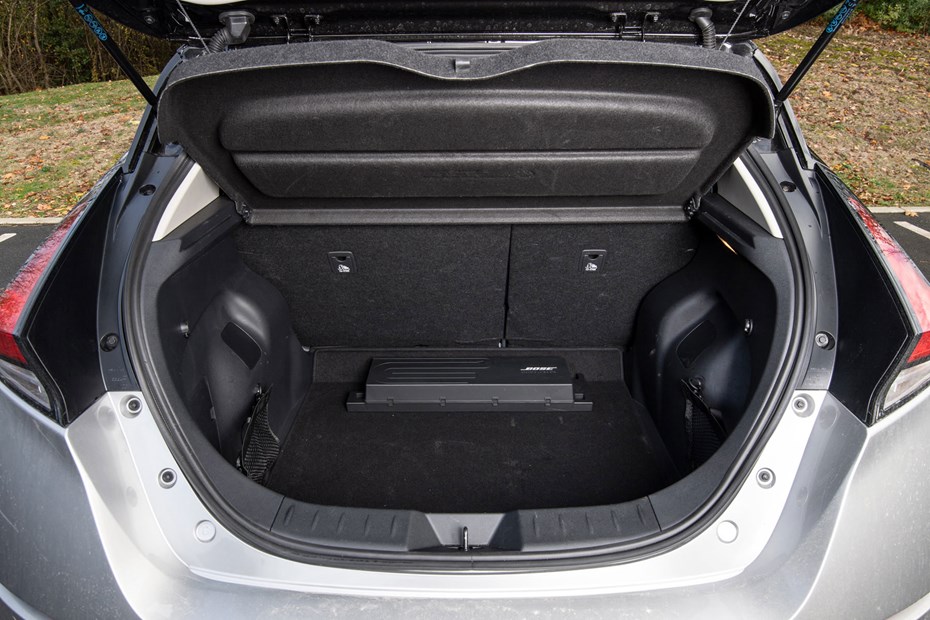
- Space to seat five relatively comfortably
- Boot space stands up to PHEV rivals
- Airy, pleasantly designed cabin
How much space is there?
The Nissan Leaf is sized to compete with the likes of the Ford Focus and the Volkswagen Golf – which gives us a good yardstick for how much room there is inside. The Nissan’s cabin is comparatively airy feeling, with plenty of headroom – which is good news given the relatively high seating position.
There’s also slightly more space in the rear than you get in a Focus or a Golf, due to the flat floor. As the Leaf is an EV, there’s no need for a hump between the seats to make space for the exhaust system or any drivetrain components. This liberates a little more foot-room for back seat passengers and allows three to sit next to each other in relative comfort.
Nissan Leaf boot space and storage
The Nissan Leaf offers a generous 435 litres of boot space with the rear seats in place, slightly more than you got in the previous-generation Leaf (which is based on the same platform) and substantially bigger than direct rivals such as the VW ID.3 (385 litres) and MG4 EV (365 litres). The boot floor is quite deep, which means you need to haul items up and over the rear bumper to get them in the – but if you can live with that it’s worth it for the space on offer.

The battery pack under the rear seats means you don’t get a completely flat load floor when the rear seats are folded, though. And while storage space increases to 1,176 litres in this configuration, that’s 91 litres less than you get in the ID.3. It’s also worth noting that the subwoofer that comes as part of the Bose hi-fi speaker upgrade robs some boot space on higher-specification Leaf models.
Moving into the passenger cabin, the centre console has plenty of cubbies for your odds and ends, while the front door bins have pockets big enough for large water bottles.
Is it easy to park?
The glasshouse is quite wide, which means it’s easy to see what’s around you if you like to park the old fashioned way. The entry-level Leaf Acenta also comes as standard with a helpful rear-view camera for some added assistance – although you don’t get parking sensors.
This is remedied if you opt for the more expensive N-Connecta variant, which comes with front and rear parking sensors and a comprehensive 360-degree parking camera. Range-topping Tekna models can also be specified with Nissan’s ProPilot Park system, which can automatically steer the Leaf into both end-on and parallel parking spaces.
Safety
- Five-star Euro NCAP safety rating in 2018
- Autonomous Emergency Braking as standard
- Optional ProPilot semi-autonomous driving mode
The Leaf was last crash tested by Euro NCAP in 2018. It achieved an overall rating of five stars overall and scored an admirable 93% in the adult occupant protection category. Although the scoring has gotten harder since, the testers were particularly impressed by the Leaf’s performance in rear-end collisions, noting how the headrests were good at preventing whiplash.
Nissan’s autonomous emergency braking system with pedestrian detection was also praised for its good performance at city speeds. The AEB system is supported by a wealth of other standard safety equipment that includes six airbags, two pairs of Isofix points on the rear bench, lane-departure warning, blindspot monitoring, hill-start assist and cross-traffic alert.
Range-topping Tekna cars also come as standard with Nissan’s ProPilot driver assistance system, which combines active cruise control and lane-keeping assist. It’s designed to make driving easier on the motorway, and can deal with stop-start traffic almost autonomously while also keeping you safely in your lane.
However, Nissan stresses that it’s only an assistance system – so if your hands leave the steering wheel for more than 10 seconds it will sound an alarm. Several manufacturers offer more sophisticated systems these days, but the Leaf’s ProPilot setup does at least seem to work consistently well.
Watch the Nissan Leaf Euro NCAP crash test video
Euro NCAP rating
| What is Euro NCAP? ⓘ | |
|---|---|
| Adult Occupant: | 93% |
| Child Occupant: | 86% |
| Vulnerable Road User: | 71% |
| Safety Assist: | 71% |
Equipment and options
- 3x3 point rear seat belts
- Alarm
- Audio remote
- Driver`s airbag
- Front electric windows
- Height adjustable drivers seat
- PAS
- Passenger`s airbag
- Rear electric windows
- Remote locking
- Side airbags
- Steering wheel reach adjustment
- Traction control
- ABS
- Air conditioning
- Electric mirrors
- Front fog lights
- Heated seats
- Isofix child seat anchor points
- Metallic Paint
- Parking sensors
- Sat Nav
- Steering wheel rake adjustment
- Alloy wheels
- Climate control
- Cloth seat trim
- ABS
- Body coloured bumpers
- Climate control
- Cloth seat trim
- Electric driver`s seat
- Electric mirrors
- Electric passenger`s seat
- Front fog lights
- Heated seats
- Isofix child seat anchor points
- Lumbar support
- Metallic Paint
- Sat Nav
- n/a
- ABS
- Air conditioning
- Body coloured bumpers
- Electric mirrors
- Heated seats
- Isofix child seat anchor points
- Metallic Paint
- Parking sensors
- Partial leather seat trim
- Sat Nav
- n/a
- Cloth seat trim
- Front fog lights
- ABS
- Air conditioning
- Alloy wheels
- Climate control
- Electric mirrors
- Isofix child seat anchor points
- Parking sensors
- Sat Nav
- Steering wheel rake adjustment
- ABS
- Air conditioning
- Body coloured bumpers
- Electric mirrors
- Heated seats
- Isofix child seat anchor points
- Parking sensors
- Partial leather seat trim
- Sat Nav
- n/a
- ABS
- Electric mirrors
- Front fog lights
- Heated seats
- Isofix child seat anchor points
- Parking sensors
- Sat Nav
- Steering wheel rake adjustment
- Air conditioning
- Alloy wheels
- Climate control
- Cloth seat trim
- ABS
- Air conditioning
- Electric mirrors
- Front fog lights
- Heated seats
- Isofix child seat anchor points
- Parking sensors
- Sat Nav
- n/a
- ABS
- Electric mirrors
- Heated seats
- Isofix child seat anchor points
- Parking sensors
- Partial leather seat trim
- Sat Nav
- Steering wheel rake adjustment
- Air conditioning
- Alloy wheels
- Climate control
- ABS
- Climate control
- Electric mirrors
- Front fog lights
- Heated seats
- Isofix child seat anchor points
- Parking sensors
- Sat Nav
- Steering wheel rake adjustment
- Air conditioning
- Alloy wheels
- Cloth seat trim
- ABS
- Alloy wheels
- Climate control
- Electric mirrors
- Front fog lights
- Heated seats
- Isofix child seat anchor points
- Parking sensors
- Sat Nav
- Steering wheel rake adjustment
- Air conditioning
- Cloth seat trim
- ABS
- Climate control
- Electric mirrors
- Heated seats
- Isofix child seat anchor points
- Parking sensors
- Partial leather seat trim
- Sat Nav
- Steering wheel rake adjustment
- Air conditioning
- Alloy wheels
- ABS
- Body coloured bumpers
- Climate control
- Cloth seat trim
- Cruise control
- Isofix child seat anchor points
- Steel wheels
- n/a
Dimensions
| Length | 4490mm |
|---|---|
| Width | 2030mm |
| Height | 1530mm - 1545mm |


